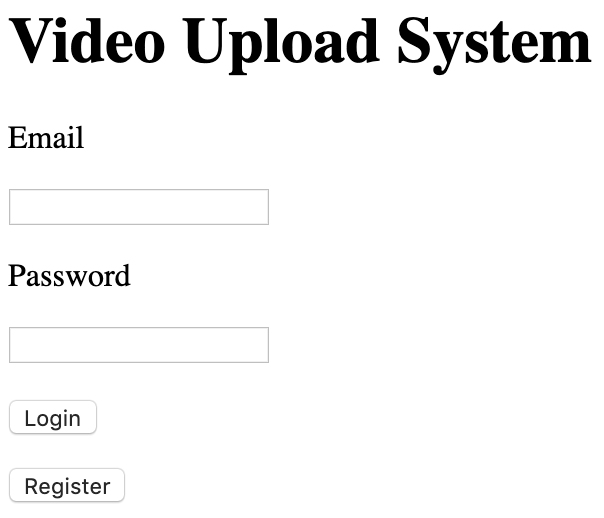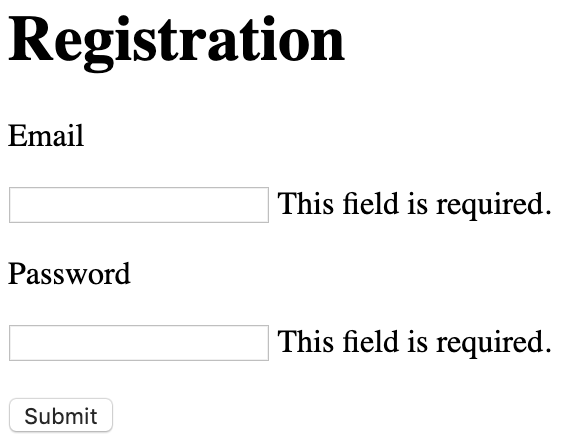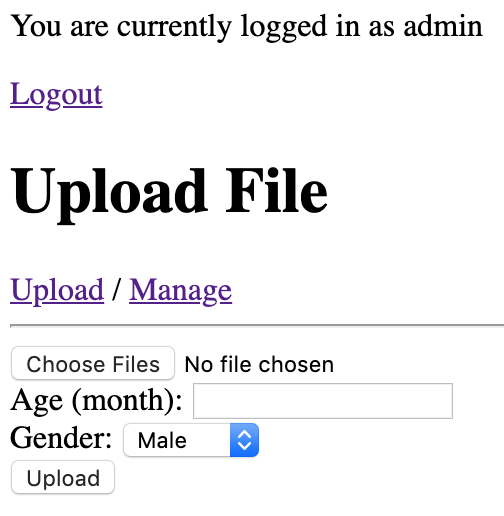- Users should register and login first on the website.
- Users can upload one or multiple videos.
- Users can check their uploaded videos.
- Users can download uploaded videos.
- Administrtor needs to login with admin account. Default account name is admin, password is 12345678.
- After login, administrator can check and download all uploaded videos by all users.
- The user needs to provide email address and password.
- The validity of email address and password is checked.
###Upload Videos
- The commonly used file types for mobile video recording should be supported (e.g. mov, mp4, 3pg, 'avi').
- The child's age and gender should be provided while uploading the video.
- The video should have size limit.
###Check Uploaded Videos
- Uploaded videos are shown in list with file name, size, upload time, child's age, child's genger, uploader's id.
- When the file name is clicked, the video is downloaded to the user's computer.
The codes are inplemented in index.html
####Register Page
The codes are inplemented in register.html
The codes are inplemented in show.html
The codes are inplemented in manage.html
# -*- coding: utf-8 -*-
import os
import time
import hashlib
from flask import Flask, render_template, redirect, url_for, request, flash, send_from_directory
from flask_mongoengine import MongoEngine, Document
from flask_uploads import UploadSet, configure_uploads, IMAGES, patch_request_class
from flask_wtf import FlaskForm
from flask_wtf.file import FileField, FileRequired, FileAllowed
from wtforms import SubmitField
from wtforms import StringField, PasswordField, IntegerField, SelectField
from wtforms.validators import Email, Length, InputRequired, NumberRange
from werkzeug.security import generate_password_hash, check_password_hash
from flask_login import LoginManager, UserMixin, login_user, login_required, logout_user, current_user
application = Flask(__name__)
application.config['SECRET_KEY'] = 'I have a dream'
application.config['UPLOADED_VIDEOS_DEST'] = '/tmp/uploads'
application.config['MONGODB_SETTINGS'] = {
'db': 'upload_video',
'host': 'mongodb://localhost:27017/upload_video'
}
db = MongoEngine(application)
login_manager = LoginManager()
login_manager.init_app(application)
login_manager.login_view = 'login'
videos = UploadSet('videos', extensions=('mov', 'mp4', 'MOV', 'MP4', '3pg', '3GP', 'avi', 'AVI'))
configure_uploads(application, videos)
patch_request_class(application, 100 * 1024 * 1024) # set maximum file size 100MB
class User(UserMixin, db.Document):
meta = {'collection': 'user_collection'}
email = db.StringField(max_length=30)
password = db.StringField()
class Video(db.Document):
meta = {'collection': 'video_collection'}
file_name = db.StringField(max_length=30)
email = db.StringField(max_length=30)
age = db.IntField()
gender = db.StringField()
class UploadForm(FlaskForm):
video = FileField(validators=[FileAllowed(videos, 'Video Only!'), FileRequired('Choose a file!')])
age = IntegerField('age', validators=[InputRequired(), NumberRange(0, 120)])
gender = SelectField('gender', choices=[('male', 'Male'), ('female', 'Female')], validators=[InputRequired()])
submit = SubmitField('Upload')
class RegForm(FlaskForm):
email = StringField('email', validators=[InputRequired(), Email(message='Invalid email'), Length(max=30)])
password = PasswordField('password', validators=[InputRequired(), Length(min=8, max=20)])
@login_manager.user_loader
def load_user(user_id):
return User.objects(pk=user_id).first()
@application.route('/register', methods=['GET', 'POST'])
def register():
form = RegForm()
if request.method == 'POST':
if form.validate():
existing_user = User.objects(email=form.email.data).first()
if existing_user is None:
hashpass = generate_password_hash(form.password.data, method='sha256')
hey = User(form.email.data, hashpass).save()
login_user(hey)
return redirect(url_for('upload_file'))
return render_template('register.html', form=form)
@application.route('/', methods=['GET', 'POST'])
def login():
if current_user.is_authenticated:
return redirect(url_for('upload_file'))
form = RegForm()
wrong_password = False
no_user = False
if request.method == 'POST':
if form.validate() or form.email.data == 'admin':
# User.
check_user = User.objects(email=form.email.data).first()
if check_user:
if check_password_hash(check_user['password'], form.password.data):
login_user(check_user)
flash('Logged in successfully.')
return redirect(url_for('upload_file'))
else:
wrong_password = True
else:
no_user = True
return render_template('index.html', form=form, wrong_password=wrong_password, no_user=no_user)
@application.route('/logout', methods=['GET'])
@login_required
def logout():
logout_user()
return redirect(url_for('login'))
@application.route('/show', methods=['GET', 'POST'])
@login_required
def upload_file():
form = UploadForm()
if form.validate_on_submit():
for file in request.files.getlist('video'):
query_video = Video.objects(email=current_user.email, file_name=file.filename).first()
if query_video is not None:
ext_num = 1
while True:
file_name = file.filename[:-4] + '_' + str(ext_num) + file.filename[-4:]
query_video = Video.objects(email=current_user.email, file_name=file_name).first()
if query_video is None:
break
else:
ext_num += 1
else:
file_name = file.filename
videos.save(file, folder=current_user.email, name=file_name)
Video(file_name=file_name, email=current_user.email, age=form.age.data, gender=form.gender.data).save()
success = True
else:
success = False
return render_template('show.html', form=form, success=success, name=current_user.email)
@application.route('/manage')
def manage_file():
files_list = []
if current_user.email == 'admin':
for email in os.listdir(application.config['UPLOADED_VIDEOS_DEST']):
email_dir = os.path.join(application.config['UPLOADED_VIDEOS_DEST'], email)
if os.path.isdir(email_dir):
for file in os.listdir(email_dir):
if not file.startswith('.'):
query_video = Video.objects(email=email, file_name=file).first()
files_list.append([file, email, query_video['age'], query_video['gender']])
else:
files = os.listdir(os.path.join(application.config['UPLOADED_VIDEOS_DEST'], current_user.email))
for file in files:
query_video = Video.objects(email=current_user.email, file_name=file).first()
files_list.append([file, current_user.email, query_video['age'], query_video['gender']])
return render_template('manage.html', files_list=files_list, name=current_user.email)
@application.route('/open/<filename>')
def open_file(filename):
file_url = videos.url(filename)
return render_template('browser.html', file_url=file_url)
@application.route('/delete/<email>/<filename>')
def delete_file(filename, email):
file_path = videos.path(os.path.join(email, filename))
os.remove(file_path)
query_video = Video.objects(email=email, file_name=filename).first()
query_video.delete()
return redirect(url_for('manage_file'))
@application.route('/download/<email>/<filename>', methods=['GET', 'POST'])
def download_file(filename, email):
file_path = os.path.join(application.config['UPLOADED_VIDEOS_DEST'], email)
return send_from_directory(directory=file_path, filename=filename, as_attachment=True)
if __name__ == '__main__':
application.run(debug=True)fields: user_id, password, nickname
primary key: user_id
fields: file_name, file_path, file_size, duration, child_age, child_name, user_id, upload_time
primary key: user_id, file_name
https://www.phusionpassenger.com/library/walkthroughs/deploy/python/
sudo apt-get update
sudo apt-get install -y pythonadd the following code to .bashrc
export LC_ALL="en_US.UTF-8"sudo apt-get install -y dirmngr gnupg
sudo apt-key adv --keyserver hkp://keyserver.ubuntu.com:80 --recv-keys 561F9B9CAC40B2F7
sudo apt-get install -y apt-transport-https ca-certificates
sudo sh -c 'echo deb https://oss-binaries.phusionpassenger.com/apt/passenger xenial main > /etc/apt/sources.list.d/passenger.list'
sudo apt-get update
sudo apt-get install -y libapache2-mod-passenger
sudo apt-get install -y apache2sudo a2enmod passenger
sudo apache2ctl restartsudo /usr/bin/passenger-config validate-install
sudo /usr/sbin/passenger-memory-statssudo apt-get install -y gitsudo mkdir -p /var/www/cloud-drive
sudo chown ubuntu: /var/www/cloud-drive
cd /var/www
sudo -u ubuntu -H git clone https://github.com/jasonyanglu/cloud-drive.gitsudo apt install python-pip
sudo pip install flask
sudo pip install -r requirements.txtsudo vim /etc/apache2/sites-enabled/cloud-drive.confpaste the following codes to cloud-drive.conf
<VirtualHost *:80>
ServerName 193.112.128.7
# Tell Apache and Passenger where your app's code directory is
DocumentRoot /var/www/cloud-drive
PassengerAppRoot /var/www/cloud-drive
# Tell Passenger that your app is a Python app
PassengerAppType wsgi
PassengerStartupFile app.py
# Relax Apache security settings
<Directory /var/www/cloud-drive>
Allow from all
Options -MultiViews
# Uncomment this if you're on Apache >= 2.4:
#Require all granted
</Directory>
</VirtualHost>
重启apache
sudo apache2ctl restartwget -qO - https://www.mongodb.org/static/pgp/server-4.2.asc | sudo apt-key add -
echo "deb [ arch=amd64 ] https://repo.mongodb.org/apt/ubuntu xenial/mongodb-org/4.2 multiverse" | sudo tee /etc/apt/sources.list.d/mongodb-org-4.2.list
sudo apt-get install -y mongodbsudo service mongodb start
mongouse upload_video
db.createCollection('user_collection')
db.createCollection('video_collection')
show collections
db.user_collection.find()
After registering admin@google.com, change it to admin in the server by command:
db.user_collection.update({'email':'admin@google.com'}, {$set:{'email':'admin'}})
'/tmp/uploads'



